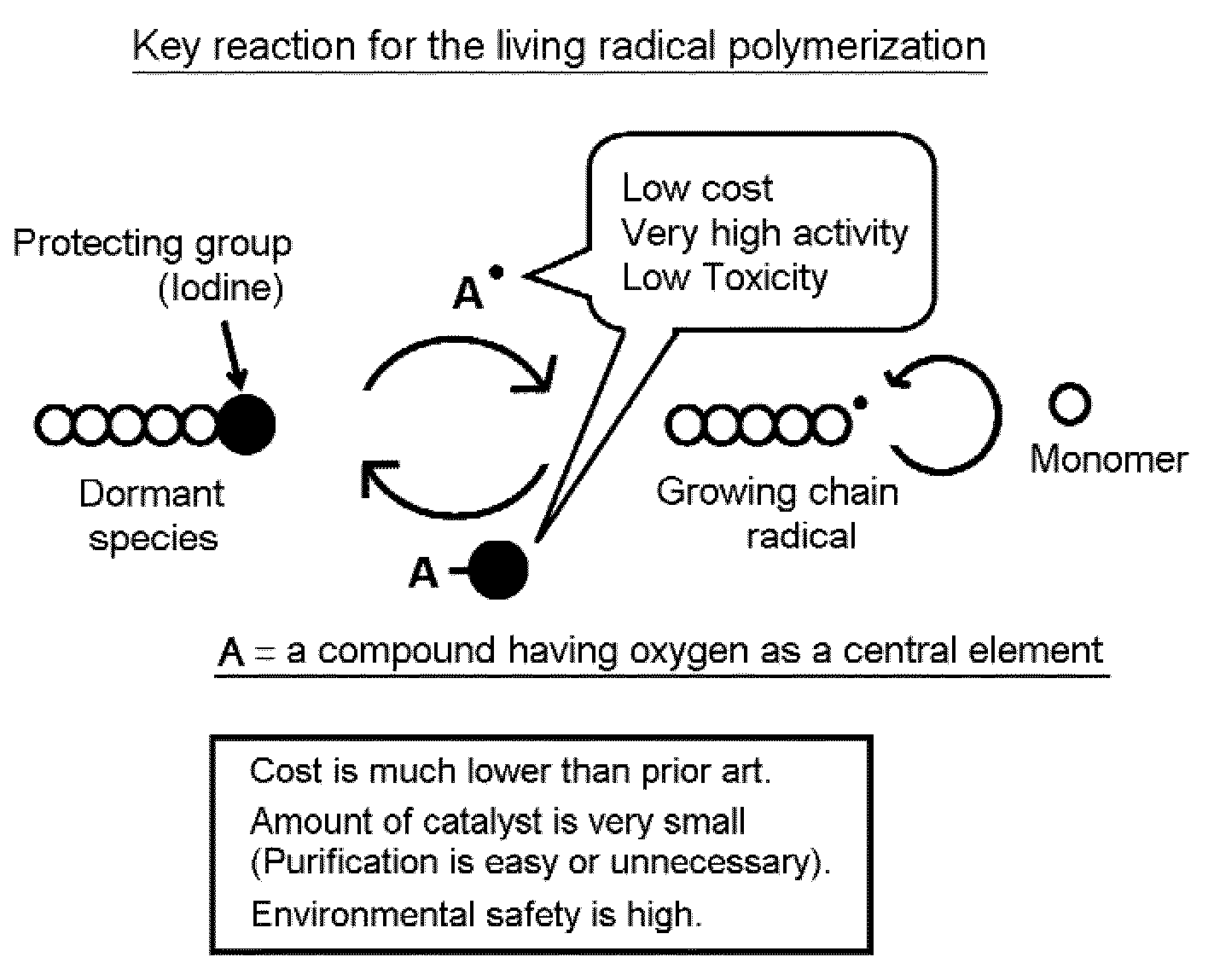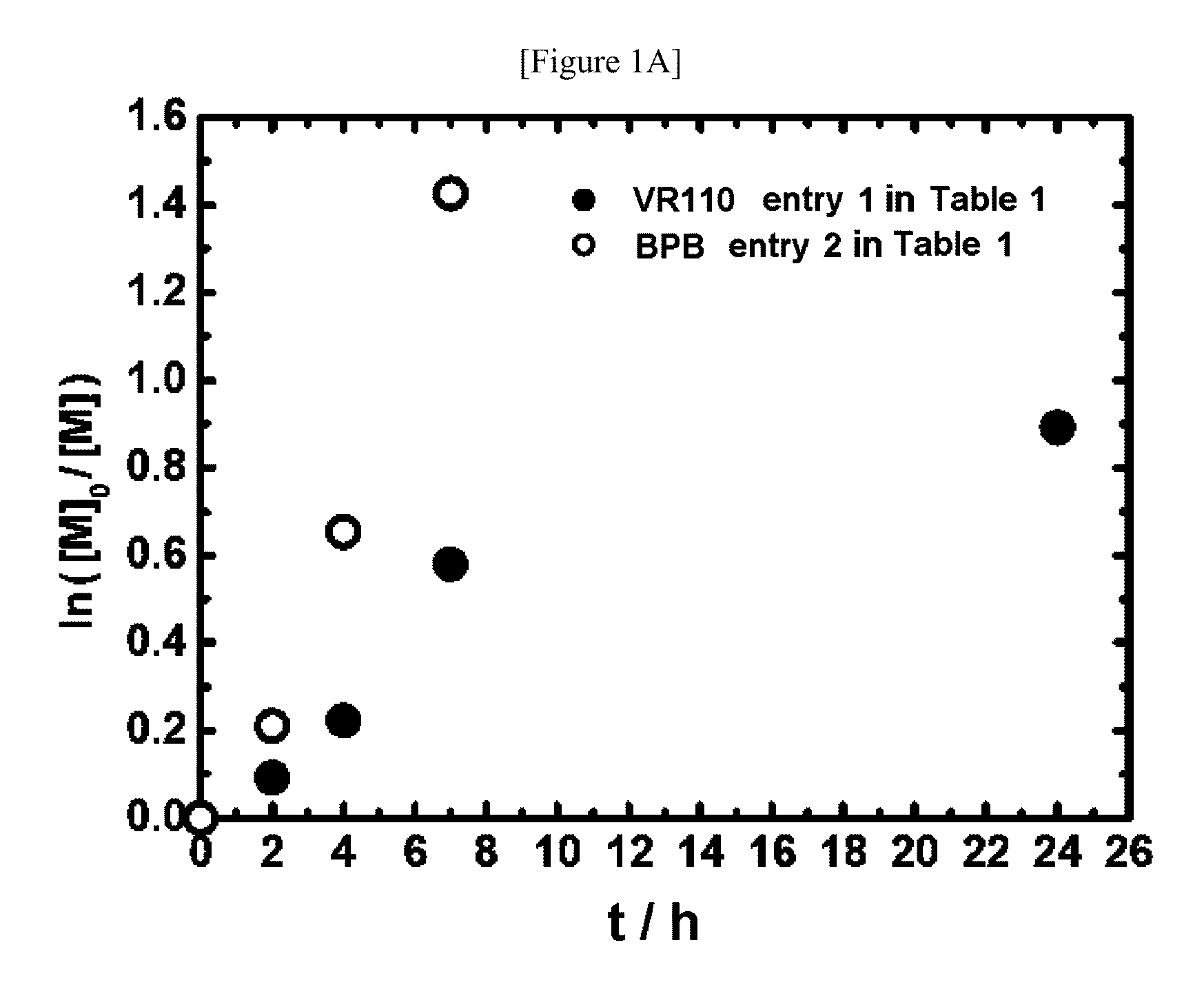Novel living radical polymerization method using alcohol as catalyst
a radical polymerization and catalyst technology, applied in the field of high-active catalysts, can solve the problems of difficult to obtain vinyl polymers with narrow molecular weight distribution, difficult to control the molecular weight of obtained vinyl polymers, etc., and achieve low toxicity, high solubility, and high activity.
- Summary
- Abstract
- Description
- Claims
- Application Information
AI Technical Summary
Benefits of technology
Problems solved by technology
Method used
Image
Examples
example 2
Homopolymerizations of Styrene (St) with Alcohol (Precursor-Type Catalyst)
[0254]Polymerization of styrene (St) was carried out similarly to Example 1 except for the changes of the reaction materials and reaction conditions, as shown in Table 2 (entries 1 to 40).
[0255]In a system similar to Example 1, however, instead of thymol iodide (TI), which is an iodide of oxygen, alcohol R—OH, which is a hydride of oxygen, was used as a precursor of a catalyst (Scheme 2). In this polymerization, a radical generated by cleavage of a radical initiator or a growing chain radical (polymer.) that is derived therefrom abstracts hydrogen of R—OH to generate R—O., which is an activated radical (Scheme 2a). Based on the action of the oxygen radical, the reversible activation is conducted (Scheme 2b).
[0256]In this Example, as a catalyst (the chemical formulas are shown above), 2,4,6-trimethylphenol (2,4,6-Me), 2,6-di-t-butyl-4-methylphenol (2,6-tBu-4-Me(BHT)), 2,4-dimethylphenol (2,4-Me), 2-isopropyl-5-...
example 3
Homopolymerizations of Styrene (St) with Alcohol (Precursor-Type Catalyst) Utilizing In Situ Synthesis of Alkyl Halide
[0261]In a system similar to Example 2, experiments were performed. However, instead of 2-cyanopropyl iodide (CP—I) isolated and purified as alkyl iodide, azobisisobutyronitrile (AIBN) and iodine (I2), which are raw materials thereof, were used as alkyl halide. Bulk homopolymerization of styrene (St) was carried out using 2,4,6-Me as a catalyst (precursor) at 80° C. (Table 3). The production process of CP—I is shown in Scheme 4. Due to the degradation of AIBN, 2-cyanopropyl radical (CP.) is generated. CP. reacts with I2 to give CP—I. After completion of the reaction of AIBN and I2, the remaining AIBN acts as a radical initiator, which provides a growing chain radical. AIBN gives free CP., which can react with I2, with efficiency of about 60%. AIBN was added in an excessive amount (2 equivalents) in comparison with I2.
[0262]Under the conditions shown in Table 3 (entry...
example 4
Homopolymerizations of Methyl Methacrylate (MMA) with Thymol Iodide (Catalyst)
[0263]Instead of the polymerizations of styrene (Example 1), the polymerizations of methyl methacrylate (MMA) were carried out. In this experiment, 2-cyanopropyl iodide (CP—I, the chemical formula is shown above) was used as an alkyl halide. The polymerizations were carried out at 95° C. using 2,2′-azobis(2,4,4-trimethylpentane) (VR110) as a radical initiator, and thymol iodide (TI) as a catalyst. The monomer concentration was 8 M. The results are shown in Table 4 (entry 1). When 80 mM of CP—I, 40 mM of VR110, and 15 mM of the catalyst were used, for example, the conversion ratio was 37% in 4 h, and a polymer having narrow molecular weight distribution (Mn=3800, PDI=1.37) was obtained. As described above, by using TI, the polymerization of MMA was successfully controlled.
TABLE 4HOMOPOLYMERIZATIONS OF METHYL METHACRYLATE (MMA) WITHTHYMOL IODIDE (CATALYST)[R—I]0 / Monomer[I]0 / conversion(equivalentTemperature[c...
PUM
| Property | Measurement | Unit |
|---|---|---|
| Reaction temperature | aaaaa | aaaaa |
| Temperature | aaaaa | aaaaa |
| Temperature | aaaaa | aaaaa |
Abstract
Description
Claims
Application Information
 Login to View More
Login to View More - R&D
- Intellectual Property
- Life Sciences
- Materials
- Tech Scout
- Unparalleled Data Quality
- Higher Quality Content
- 60% Fewer Hallucinations
Browse by: Latest US Patents, China's latest patents, Technical Efficacy Thesaurus, Application Domain, Technology Topic, Popular Technical Reports.
© 2025 PatSnap. All rights reserved.Legal|Privacy policy|Modern Slavery Act Transparency Statement|Sitemap|About US| Contact US: help@patsnap.com



